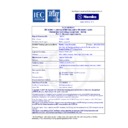JBL ON STAGE 400P (serv.man4) EMC - CB Certificate ▷ View online
- Page 13 of 53 -
Report
No.
100711
TRF No. IECEN60950_1C
2.3.2
Separation from other circuits and from accessible
parts
parts
N
2.3.2.1 General
requirements
N
2.3.2.2
Protection by basic insulation
N
2.3.2.3
Protection by earthing
N
2.3.2.4
Protection by other constructions ......................... :
N
2.3.3
Separation from hazardous voltages
N
Insulation
employed............................................... :
⎯
2.3.4
Connection of TNV circuits to other circuits
N
Insulation
employed............................................... :
⎯
2.3.5
Test for operating voltages generated externally
N
2.4
Limited current circuits
⎯
2.4.1 General
requirements
No limited current circuits.
N
2.4.2 Limit
values
N
Frequency
(Hz) ...................................................... :
⎯
Measured
current (mA).......................................... :
⎯
Measured
voltage (V) ............................................ :
⎯
Measured circuit capacitance (nF or µF)............... :
⎯
2.4.3
Connection of limited current circuits to other
circuits
circuits
N
2.5
Limited power sources
⎯
a) Inherently limited output
No limited power sources.
N
b) Impedance limited output
N
c) Regulating network limited output under normal
operating and single fault condition
operating and single fault condition
N
d) Overcurrent protective device limited output
N
Max. output voltage (V), max. output current (A),
max. apparent power (VA)..................................... :
max. apparent power (VA)..................................... :
⎯
Current rating of overcurrent protective device (A) .:
⎯
2.6
Provisions for earthing and bonding
⎯
2.6.1 Protective
earthing
Class III equipment.
N
2.6.2 Functional
earthing
N
- Page 14 of 53 -
Report
No.
100711
TRF No. IECEN60950_1C
2.6.3
Protective earthing and protective bonding
conductors
conductors
N
2.6.3.1 General
N
2.6.3.2
Size of protective earthing conductors
N
Rated current (A), cross-sectional area (mm
2
),
AWG ...................................................................... :
⎯
2.6.3.3
Size of protective bonding conductors
N
Rated current (A), cross-sectional area (mm
2
),
AWG ...................................................................... :
⎯
Protective current rating (A), cross-sectional area
(mm
(mm
2
), AWG........................................................... :
⎯
2.6.3.4
Resistance of earthing conductors and their
terminations; resistance (
terminations; resistance (
Ω), voltage drop (V), test
current (A), duration (min) ..................................... :
N
2.6.3.5 Colour
of insulation................................................ :
N
2.6.4 Terminals
N
2.6.4.1 General
N
2.6.4.2
Protective earthing and bonding terminals
N
Rated current (A), type, nominal thread diameter
(mm)....................................................................... :
(mm)....................................................................... :
⎯
2.6.4.3
Separation of the protective earthing conductor
from protective bonding conductors
from protective bonding conductors
N
2.6.5
Integrity of protective earthing
N
2.6.5.1
Interconnection of equipment
N
2.6.5.2
Components in protective earthing conductors and
protective bonding conductors
protective bonding conductors
N
2.6.5.3
Disconnection of protective earth
N
2.6.5.4
Parts that can be removed by an operator
N
2.6.5.5
Parts removed during servicing
N
2.6.5.6 Corrosion
resistance
N
2.6.5.7
Screws for protective bonding
N
2.6.5.8
Reliance on telecommunication network or cable
distribution system
distribution system
N
2.7
Overcurrent and earth fault protection in primary circuits
⎯
2.7.1 Basic
requirements
Class III equipment.
N
Instructions when protection relies on building
installation
installation
N
2.7.2
Faults not simulated in 5.3.7
N
- Page 15 of 53 -
Report
No.
100711
TRF No. IECEN60950_1C
2.7.3
Short-circuit backup protection
N
2.7.4
Number and location of protective devices .......... :
N
2.7.5
Protection by several devices
N
2.7.6 Warning
to
service personnel................................ :
N
2.8 Safety
interlocks
⎯
2.8.1 General
principles
No safety interlocks.
N
2.8.2 Protection
requirements
N
2.8.3 Inadvertent
reactivation
N
2.8.4 Fail-safe
operation
N
2.8.5 Moving
parts
N
2.8.6 Overriding
N
2.8.7
Switches and relays
N
2.8.7.1 Contact
gaps (mm) ............................................... :
N
2.8.7.2 Overload
test
N
2.8.7.3 Endurance
test
N
2.8.7.4
Electric strength test
N
2.8.8 Mechanical
actuators
N
2.9 Electrical
insulation
⎯
2.9.1
Properties of insulating materials
Class III equipment, only
functional insulation provided.
Refer to Cl. 5.3.4
functional insulation provided.
Refer to Cl. 5.3.4
N
2.9.2 Humidity
conditioning
No test considered necessary.
N
Relative humidity (%), temperature (°C) ............... :
⎯
2.9.3
Grade of insulation
Insulation is considered to be
functional insulation, and
complies with 5.3.4 c).
functional insulation, and
complies with 5.3.4 c).
P
2.9.4
Separation from hazardous voltages
Class III equipment
N
Method(s) used ..................................................... :
⎯
2.10
Clearances, creepage distances and distances through insulation
⎯
2.10.1 General
Class III equipment powered
from a secondary (SELV)
circuit from a external PSU.
Only functional insulation is
considered.
from a secondary (SELV)
circuit from a external PSU.
Only functional insulation is
considered.
P
2.10.1.1 Frequency ............................................................. :
N
- Page 16 of 53 -
Report
No.
100711
TRF No. IECEN60950_1C
2.10.1.2 Pollution degrees .................................................. :
N
2.10.1.3
Reduced values for functional insualtion
N
2.10.1.4
Intervening unconnected conductive parts
N
2.10.1.5
Insulation with varying dimensions
N
2.10.1.6
Special separation requirements
N
2.10.1.7
Insulation in circuits generating starting pulses
N
2.10.2
Determination of working voltage
Class III equipment.
N
2.10.2.1 General
N
2.10.2.2
RMS working voltage
N
2.10.2.3
Peak working voltage
N
2.10.3 Clearances
Class III equipment.
N
2.10.3.1 General
N
2.10.3.2
Mains transient voltages
N
a) AC mains supply ............................................... :
⎯
b) Earthed d.c. mains supplies .............................. :
⎯
c) Unearthed d.c. mains supplies ......................... :
⎯
d)
Battery
operation ............................................... :
⎯
2.10.3.3
Clearances in primary circuits
N
2.10.3.4
Clearances in secondary circuits
Only functional insulation is
considered. Refer also to
5.3.4.
considered. Refer also to
5.3.4.
N
2.10.3.5
Clearances in circuits having starting pulses
N
2.10.3.6 Transients
from
a.c. mains supply ........................ :
N
2.10.3.7 Transients
from
d.c. mains supply ........................ :
N
2.10.3.8
Transients from telecommunication networks and
cable distribution systems ..................................... :
cable distribution systems ..................................... :
N
2.10.3.9
Measurement of transient voltage levels
N
a) Transients from a mains suplply
⎯
For an a.c. mains supply ....................................... :
⎯
For a d.c. mains supply ......................................... :
⎯
b) Transients from a telecommunication network :
⎯
2.10.4 Creepage
distances
Class III equipment
N
2.10.4.1 General
N
2.10.4.2
Material group and caomparative tracking index
N
CTI
tests................................................................. :
⎯
2.10.4.3
Minimum creepage distances
Class III equipment.
N
Click on the first or last page to see other ON STAGE 400P (serv.man4) service manuals if exist.

